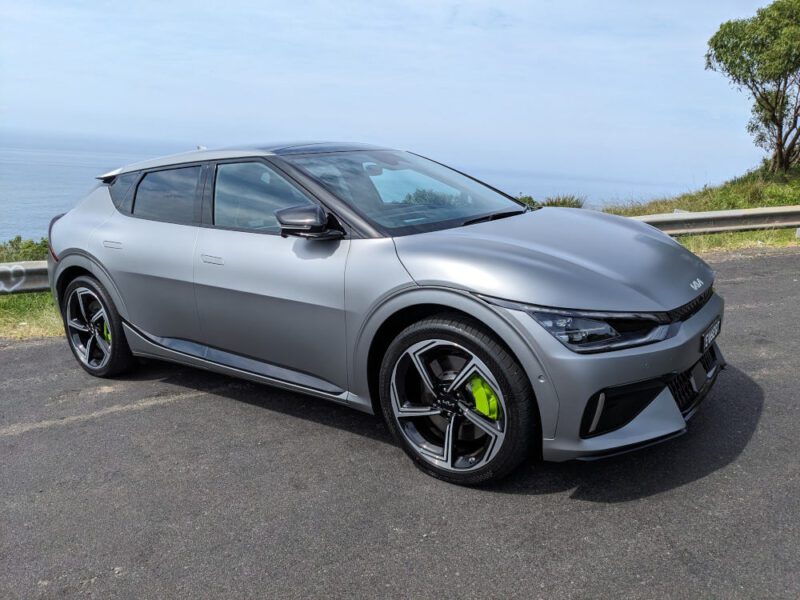Kia delivered their first EV6 electric SUVs to Australian customers two years ago and launched the high performance EV6 GT variant one year later. The EV6 GT was subsequently crowned World Performance Car of the Year in 2023.
Several new performance focused electric vehicles have arrived in Australia since the EV6 GT such as the Hyundai Ioniq 5 N and Ford Mustang Mach-E GT. The BYD Seal Performance and MG4 XPOWER also pack plenty of power for significantly less money than these other vehicles.
The Kia EV6 GT is still the most powerful car that Kia has produced, although it is no longer the most expensive. The $99,590 starting price for the EV6 GT has been surpassed by the 7-seater Kia EV9 which sells for as much as $121,000 plus on-road costs for the GT-Line variant.
I recently spent a week with an EV6 GT press vehicle from Kia to compare it with other performance focused electric vehicles, and to see what all the hype is about.
The EV6 GT I tested includes optional Moonscape matte finish paint for $3,295 and takes the driveaway price in NSW to just over $115,000 for this vehicle.
Exterior design and storage
Overall the EV6 GT is a good looking car, muscular and sporty while remaining sleek and stylish. Flush door handles pop out as you approach with the key and retract again once you drive away. On several occasions throughout the week passers-by commented on how much they liked the design of the EV6, both men and women alike.
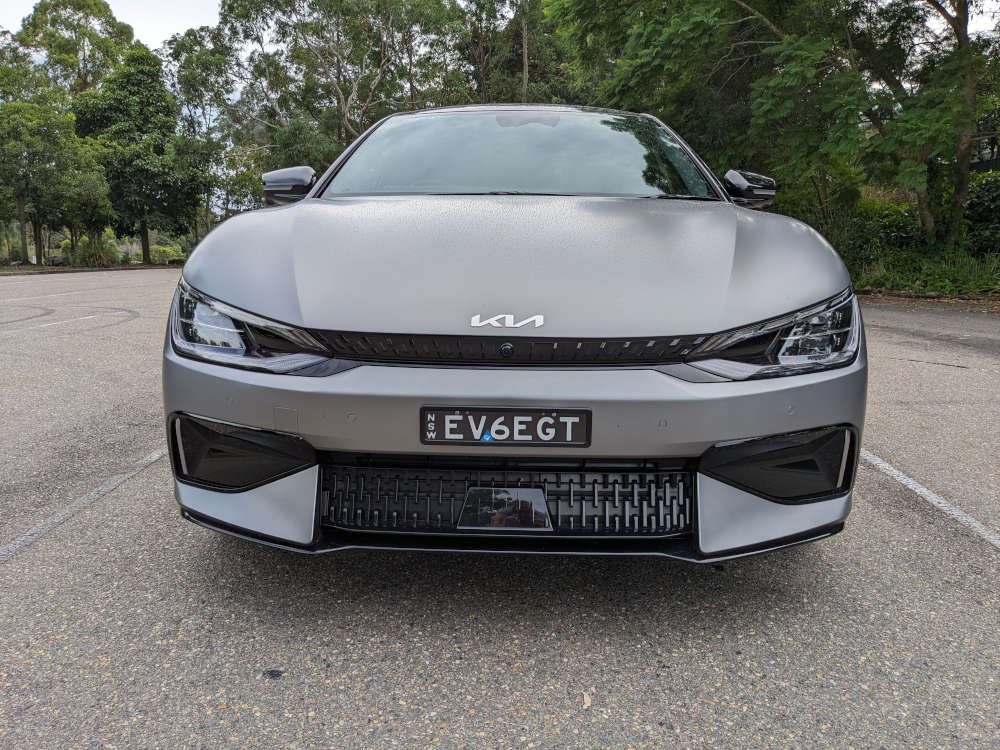
There is no denying the EV6 GT has a mean, aggressive looking face. If you are trying to tell the GT apart from other EV6 variants, its large 21 inch wheels and neon green brake callipers would be the easiest way. There is also subtle GT badging on the rear and minor changes to the headlights which are upgraded to matrix LED in the GT.

Being an SUV, the EV6 GT comes with a large hatchback opening and 480 L of storage in the boot with the rear seats up, expanding to 1260 L with the rear seats folded. There is a shallow storage space beneath the boot floor that is sufficient for storing charging cables and the vehicle to load (V2L) adapter for the charge port.
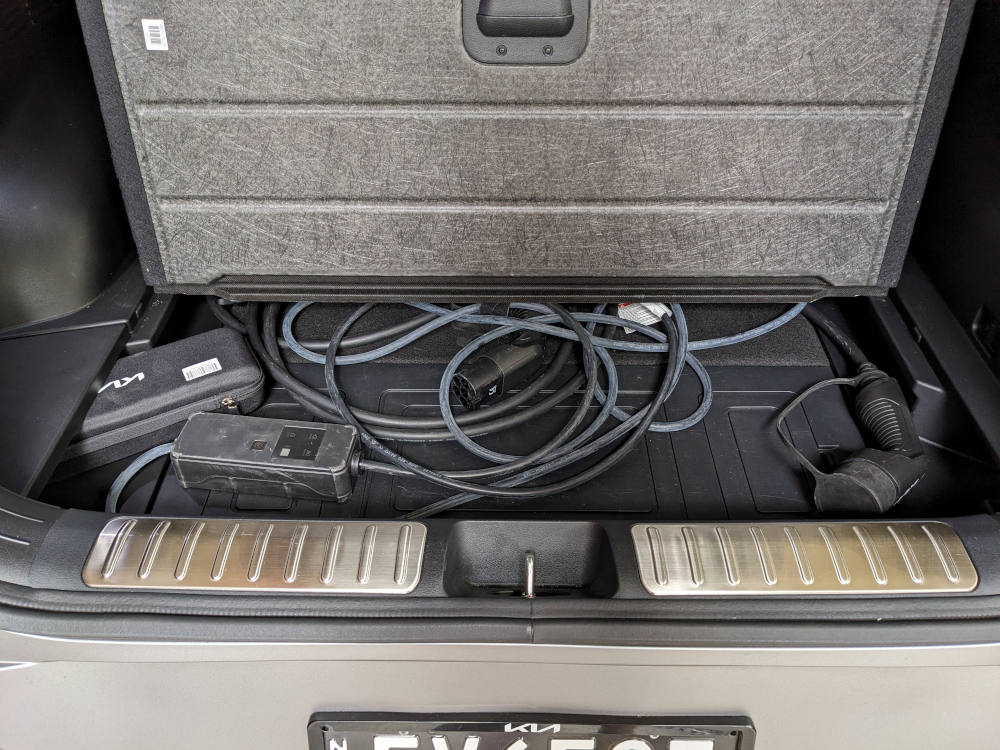
However, the tyre repair kit is too thick to fit under the boot floor and there are no cubby holes or nets to hold loose items in place, something I noticed was lacking when bringing some groceries home from the shops.
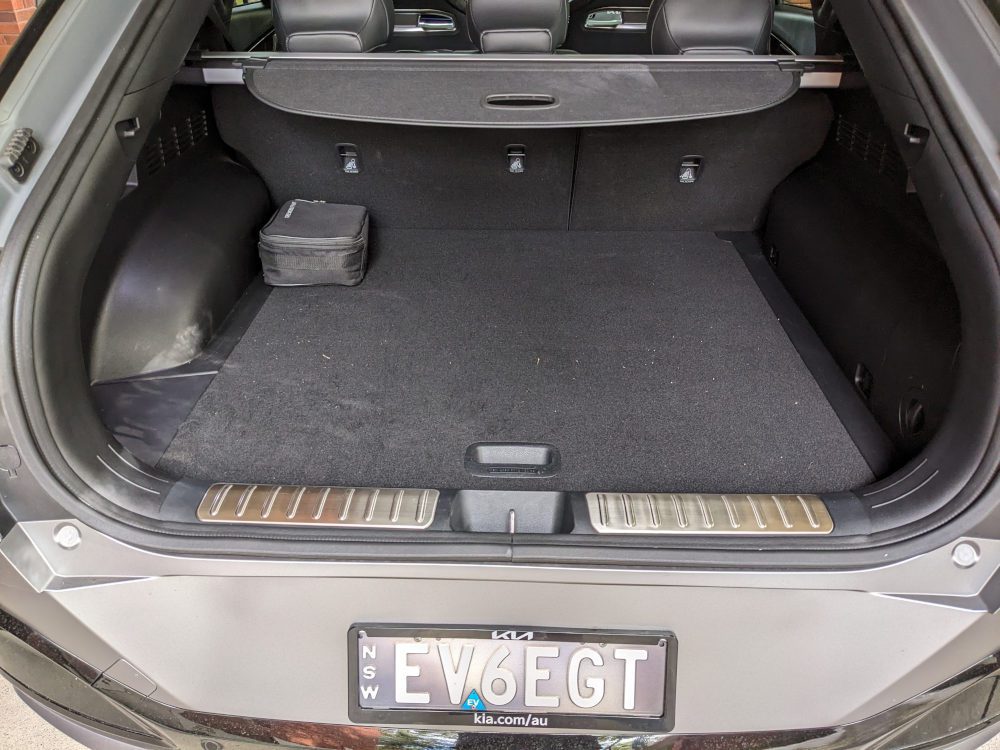
Up front there is a small 20 L front trunk (frunk) although I doubt people will use it much given its size and two step process of popping the bonnet from inside before unlatching it from the outside. Overall though, storage space is decent in the EV6 and it should accommodate the needs of most people.
Once inside the EV6, I found visibility somewhat hampered by the vehicle design. The high front wheel arches make it hard to tell where the front corners of the vehicle are when navigating tight spaces. Chunky side mirrors also block the view out of the driver’s side window, particularly when making right-hand turns.
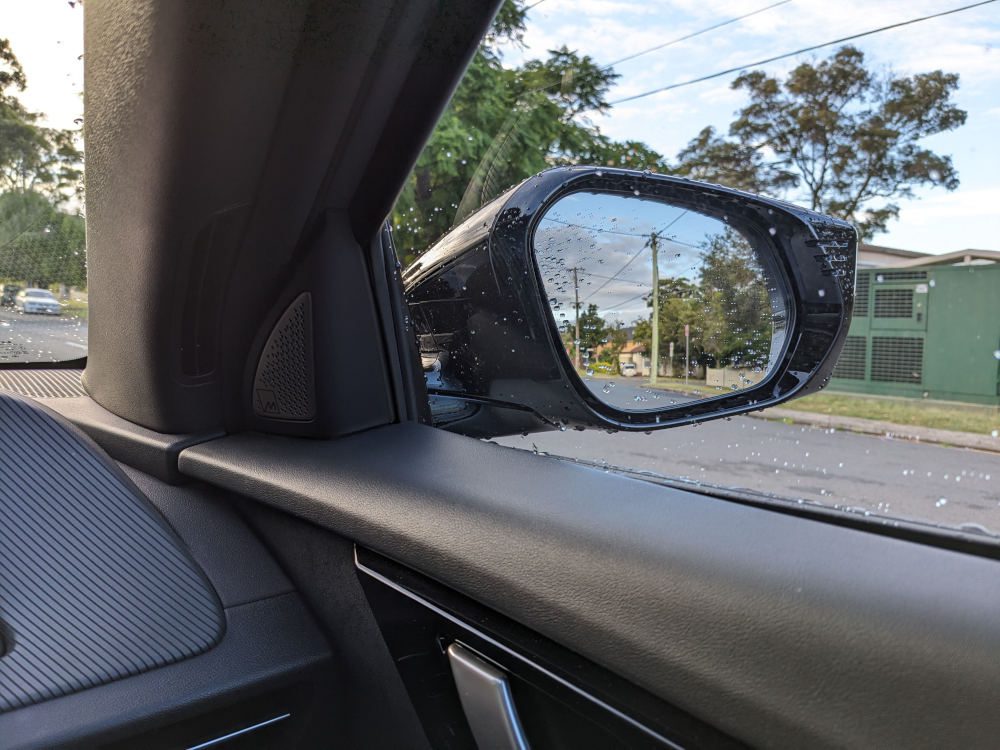
To make up for reduced visibility, the EV6 GT is fitted with several cameras which offer clear views all around the car as well as a top down 360 degree view for parking. Like other Kia and Hyundai vehicles, a blind spot view camera appears on the dash when you switch on the indicators.
Interior and infotainment
The EV6 GT interior is spacious, comfortable and feels well built. It also feels appropriately premium considering the price of this vehicle with soft materials and good sound insulation. Interior highlights include the 14 speaker Meridian Premium system which sounds great, as well as plenty of storage space for bottles and other items.

Software and dual 12.3 inch curved screens in the Kia EV6 GT are similar to other Kia and Hyundai vehicles such as the Ioniq 5 and new generation Kona EV. The screens are responsive and fairly intuitive to use, plus the EV6 supports wired Android Auto and Apple CarPlay. Unfortunately wireless Android Auto and Apple CarPlay as well as over-the-air (OTA) updates are not available for the EV6 yet.
EV6 GT-Line and GT variants also include a heads up display, although I ended up switching this off after finding it distracting in my field of view at night time. During the day it was faded and hard to see properly when wearing polarised sunglasses. The driver’s display behind the steering wheel shows all of the necessary driving information anyway.
Seating is another area where the EV6 GT differentiates itself from other EV6 variants, featuring green stitching throughout to match the brake callipers. Rear seat passengers get plenty of legroom, heated reclining seats, USB-C charging ports and air vents on the B pillars. Middle seat passengers may get hot on longer trips as there aren’t any vents on the back of the centre console.
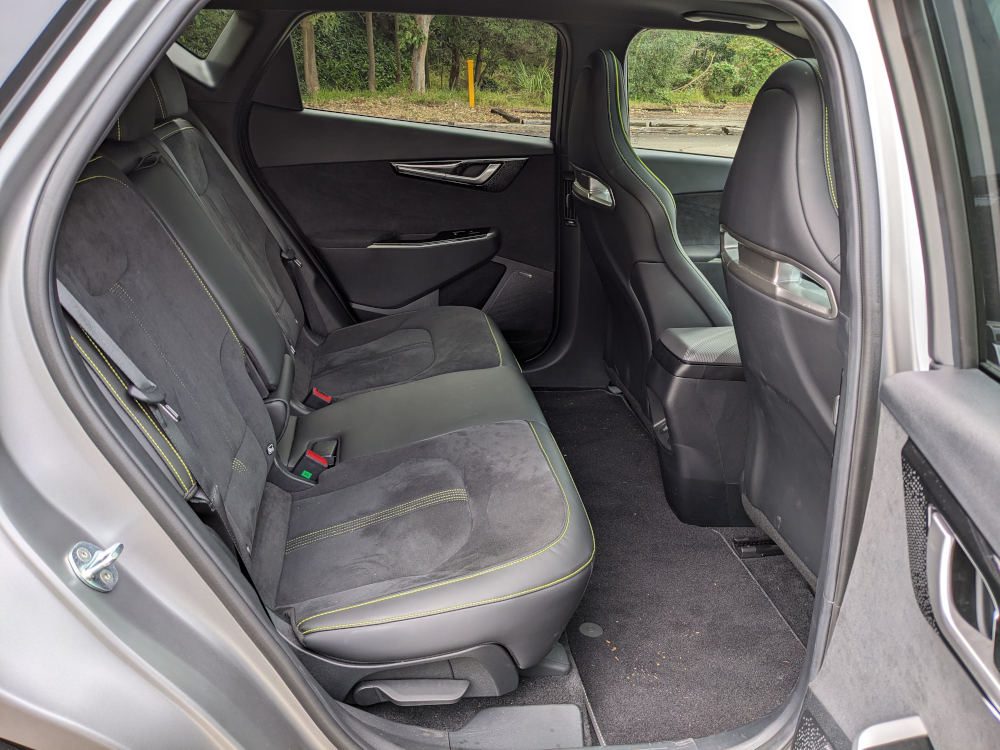
Front bucket seats in the EV6 GT are manually adjusted unlike the electronic seats found in all other versions of the EV6. Despite having less adjustment I still found them easy to get into a comfortable position and they were very supportive while cornering. After a few hours of driving I did notice some discomfort though.
The front seats can still be adjusted to lay almost flat if you need a rest while charging, giving you an opportunity to look out the sunroof above the front seats. The electronic sunroof opens all the way up for fresh air otherwise the blind can be closed for hot sunny days.
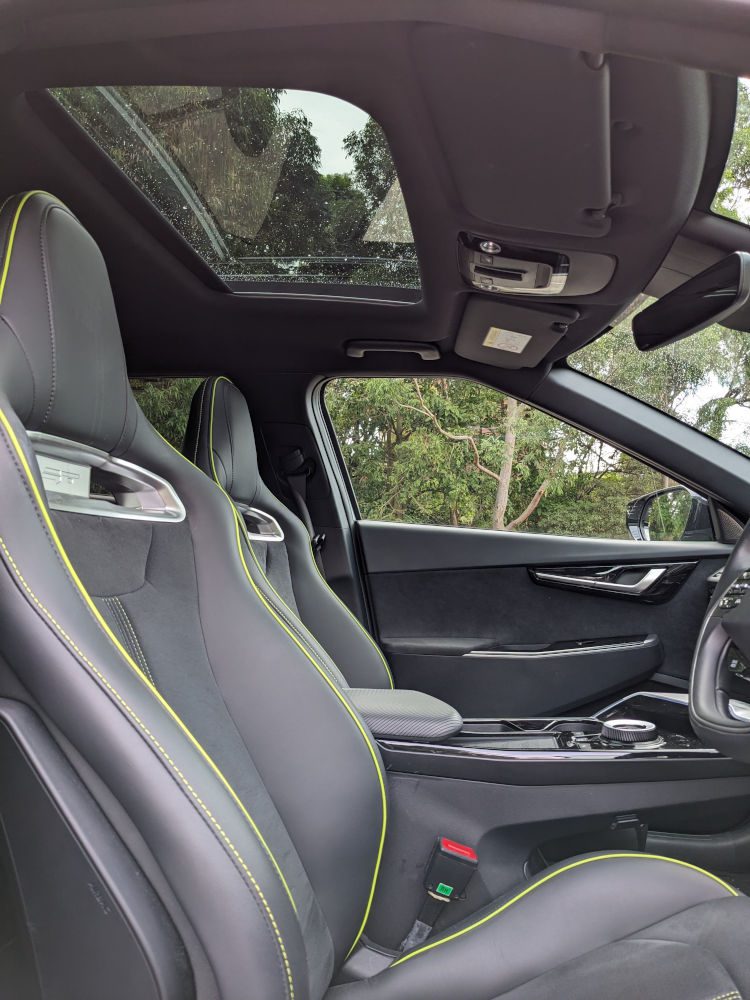
Superb driving experience
Driving the EV6 GT was loads of fun and I quickly discovered why it deserved to win World Performance Car of the Year last year. Unfortunately I was unable to drive it on a racetrack like fellow contributor Bryce Gaton did a year ago, so my judgement was based on normal everyday driving conditions.
The EV6 GT has strong and well tuned regenerative braking which is controlled by paddles behind the steering wheel. Full one pedal driving, or i-Pedal as Kia calls it, is activated when the strongest level 4 setting is chosen. Similar to other Kia and Hyundai electric vehicles, regenerative braking drops back to level 3 either when reverse gear is selected or each time the car starts.
Personally I find this regenerative braking behaviour annoying as I would much rather the pedals behaved consistently no matter which direction you are driving. Thankfully, enabling i-Pedal in the EV6 is less annoying compared to my experience in Hyundais because you can activate it while still in park.
Attempting to activate i-Pedal while parked in a Hyundai gives you a message saying, “Recuperation Conditions Not Met” and forces you to wait until actually moving forwards. It would be nice if there was a setting giving people the choice to leave it permanently enabled.
Three main driving modes are available in the EV6 GT – Eco, Normal and Sport, controlled with a drive mode button on the steering wheel. A separate neon green GT button toggles between GT and MY driving mode where you can individually customise how the motors, steering, suspension, electronic limited slip differential (e-LSD) and electronic stability control (ESC) behave.
Switching between driving modes in the EV6 GT changes the whole character of the car, unlike some cars where it seems to only change the accelerator pedal mapping. In Eco mode the car feels slow and relaxed while Normal is well suited to everyday driving, with ample power available when necessary and well weighted steering.
Flick it into Sport mode and everything in the EV6 GT tightens up and becomes instantly responsive, like a stretched elastic band waiting to be unleashed as you rocket out of corners. The driver’s display changes along with the drive mode to show a torque bar in Sport and GT modes. The ambient lighting in the car can also be set to match drive modes.
The EV6 GT features electronic controlled suspension as well as upgraded McPherson Struts with double ball joints on the front. During local development Kia tuned the EV6 for Australian roads and the end result is astounding. The EV6 GT handles superbly with such poise and confidence that cornering just feels effortless.
Suspension in the EV6 GT is firm as you would expect in a car capable of handling like this, but is not harsh over bumps which is surprising given the 21 inch wheels fitted with low profile Michelin Pilot Sport 4S tyres.
In terms of driver assistance systems and monitoring, the EV6 GT is fitted with all of the safety aids you would expect. Similar to activating i-Pedal, I found the driver assistance systems less obtrusive in the EV6 compared to equivalent systems in Hyundai vehicles I have tested.
The single exception to this is the lane keeping aid which was overzealous and sometimes tugged at the wheel when you were not expecting it. It can be adjusted through the settings to warn only, but resets to warn and intervene each time the car starts. Adaptive cruise control with lane centering worked well apart from wandering in the lane a bit.
All the performance on offer in the EV6 GT does affect efficiency as I observed just under 20 kWh/100 km throughout my testing. The car consumed 19.9 kWh/100 km on the highway and 19.8 kWh/100 km around town. My city driving consisted of mostly short trips though, so it should be possible to use less energy with longer trips.
Charging and ownership
Kia and Hyundai’s 800 V e-GMP architecture enables some of the quickest DC fast charging speeds for electric vehicles. Kia claims charging from 10-80 % on a 350 kW charger will take only 18 minutes in the EV6, although the maximum charge speed is actually around 235 kW.
I pulled up to a 350 kW Chargefox station with 8 % state of charge and the vehicle maxed out just over 220 kW. On that occasion I charged up to 59 % which only took 13 minutes, just enough time to buy a coffee and take a quick bathroom break before unplugging.
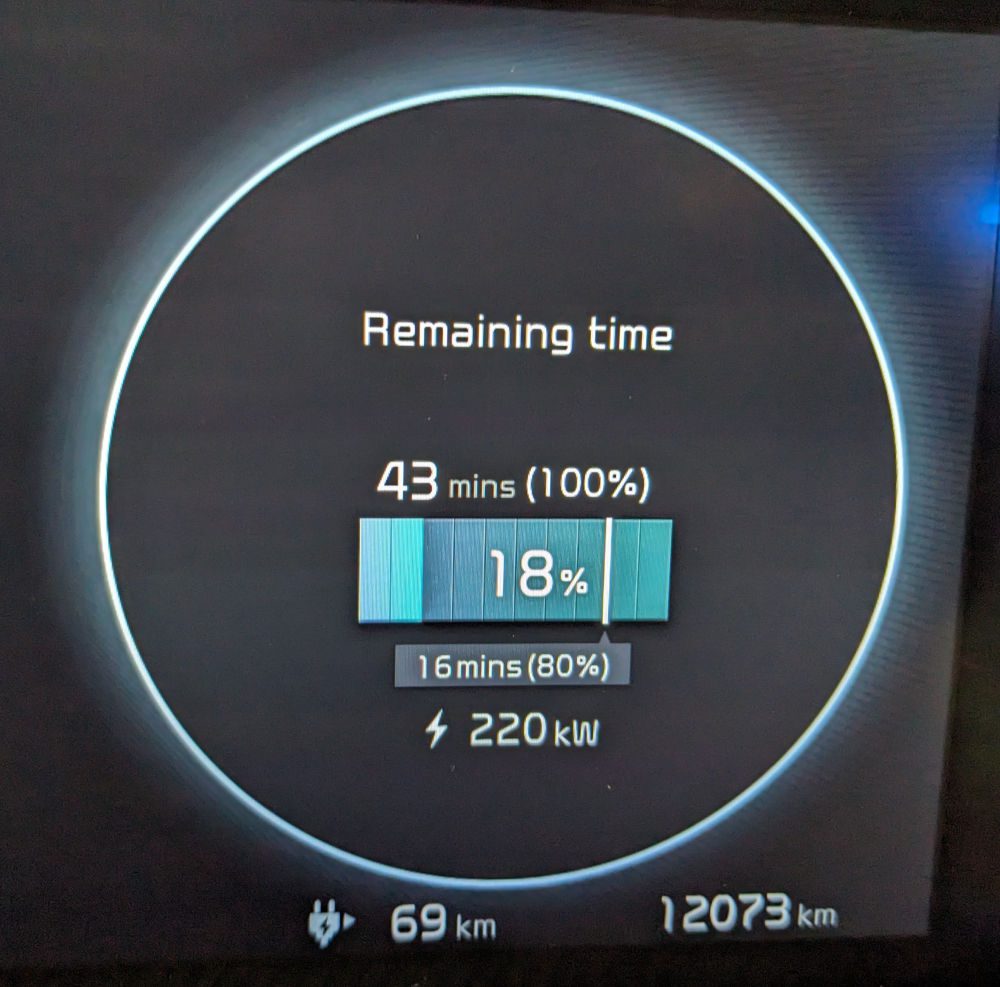
The charge port on the EV6 is nicely concealed at the rear driver’s side next to the boot opening which should allow easy access to public chargers without having to drape heavy cables across the car.
Vehicle to load (V2L) capable of up supplying up to 3.5 kW is available via the supplied V2L adapter for the charge port or a standard 15 A outlet below the rear seats. For more information on using V2L with the EV6, see fellow contributor Bryce Gaton’s review from a year ago where he used an EV6 GT to fire up a BBQ.
When it comes to planning a road trip, the built-in navigation system in the EV6 GT falls short of other systems which automatically add charging stops along the way. Navigating to somewhere far away alerts you that the battery charge is insufficient, but the button to search for charging stations only finds nearby chargers which is not helpful.
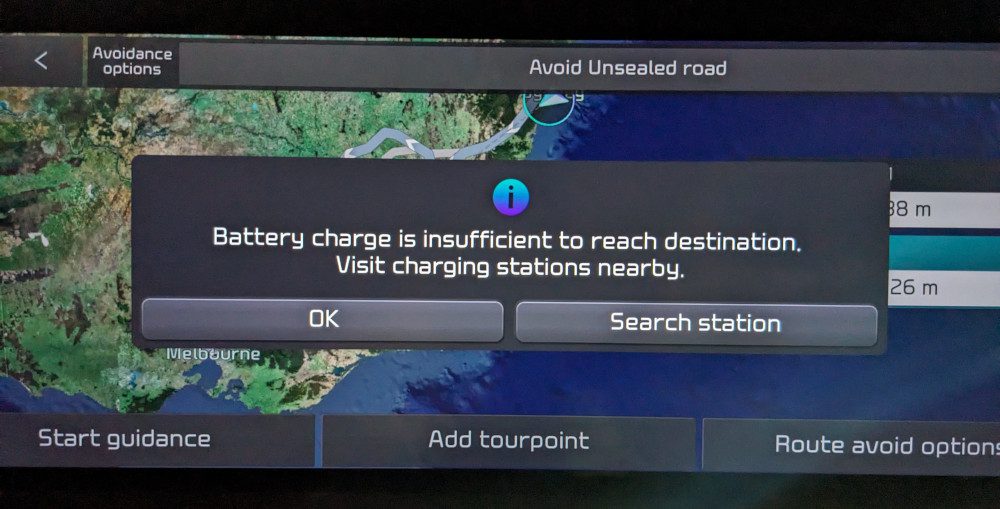
If you need to tow something, the EV6 GT has the highest towing capacity in the EV6 range. All EV6s can tow 750 kg unbraked and support 100 kg max towball weight. Braked towing capacity on the GT is 1,800 kg, 200 kg more than Air and GT-Line variants.
Just like other Kia vehicles, the EV6 GT is covered by a lengthy 7 year unlimited km warranty although the high voltage battery and drivetrain is shorter than the average at 7 years and 150,000 km.
Prepaid service plans are available for the EV6 GT covering 3, 5 or 7 years for $835, $1,561 and $2,309 respectively. Roadside assistance is also included throughout the warranty period plus one additional year as long as the vehicle is regularly serviced at a Kia dealership.
Conclusions
I went into this review with high expectations of the Kia EV6 GT, based on accolades it received plus many positive stories I heard from owners and reviewers. The EV6 GT lived up to these expectations and raised the bar for the best performance electric vehicle I have tested so far.
A year on from the EV6 GT release there is much more competition in the performance EV segment, although the EV6 GT remains one of the best.
Other EVs at the top of this category are the Hyundai Ioniq 5 N and Porsche Taycan, both receive high praise from other reviewers so I am keen to test them. Rumours surrounding the refreshed Tesla Model 3 Performance or Plaid also sound interesting.
Kia has room for improvement with the EV6 GT in some areas such as built-in trip planning with EV charging stops, lane keeping aid and drivetrain efficiency.
However, these are minor issues and do not detract from the overall performance or appeal of this car. Some of these issues may already be addressed in newer EV6 software as the vehicle I had seemed to be running an old version labelled “001.001.220623.”
Table of key specifications for the Kia EV6 GT:
| Variant | Kia EV6 GT | ||
| Starting price | $99,590, plus on-road costs | ||
| Paint colours and options | Runway Red – $0 Yacht Blue – $520 Snow White Pearl – $520 Aurora Black Pearl – $520 Moonscape matt – $3,295 |
||
| Battery size | 77 kWh gross, 74 kWh usable | ||
| Battery chemistry and manufacturer | Nickel Cobalt Manganese (NCM), SK | ||
| Range | 424 km WLTP | ||
| Driven wheels | All-wheel drive | ||
| Power / Torque | 430 kW / 740 Nm | ||
| Charging speed | 235 kW DC, 10.5 kW AC | ||
| Charging socket | CCS2 combo | ||
| Exterior dimensions | Length: 4695 mm Width: 1890 mm Height: 1545 mm Wheelbase: 2900 mm Ground clearance: 155 mm |
||
| Kerb weight | 2185 kg | ||
| Storage space | Frunk: 20 L Boot, rear seats up: 480 L Boot rear seats folded: 1260 L |
||
| Service interval | 12 months / 15,000 km | ||

Tim has 20 years experience in the IT industry including 14 years as a network engineer and site reliability engineer at Google Australia. He is an EV and renewable energy enthusiast who is most passionate about helping people understand and adopt these technologies.


